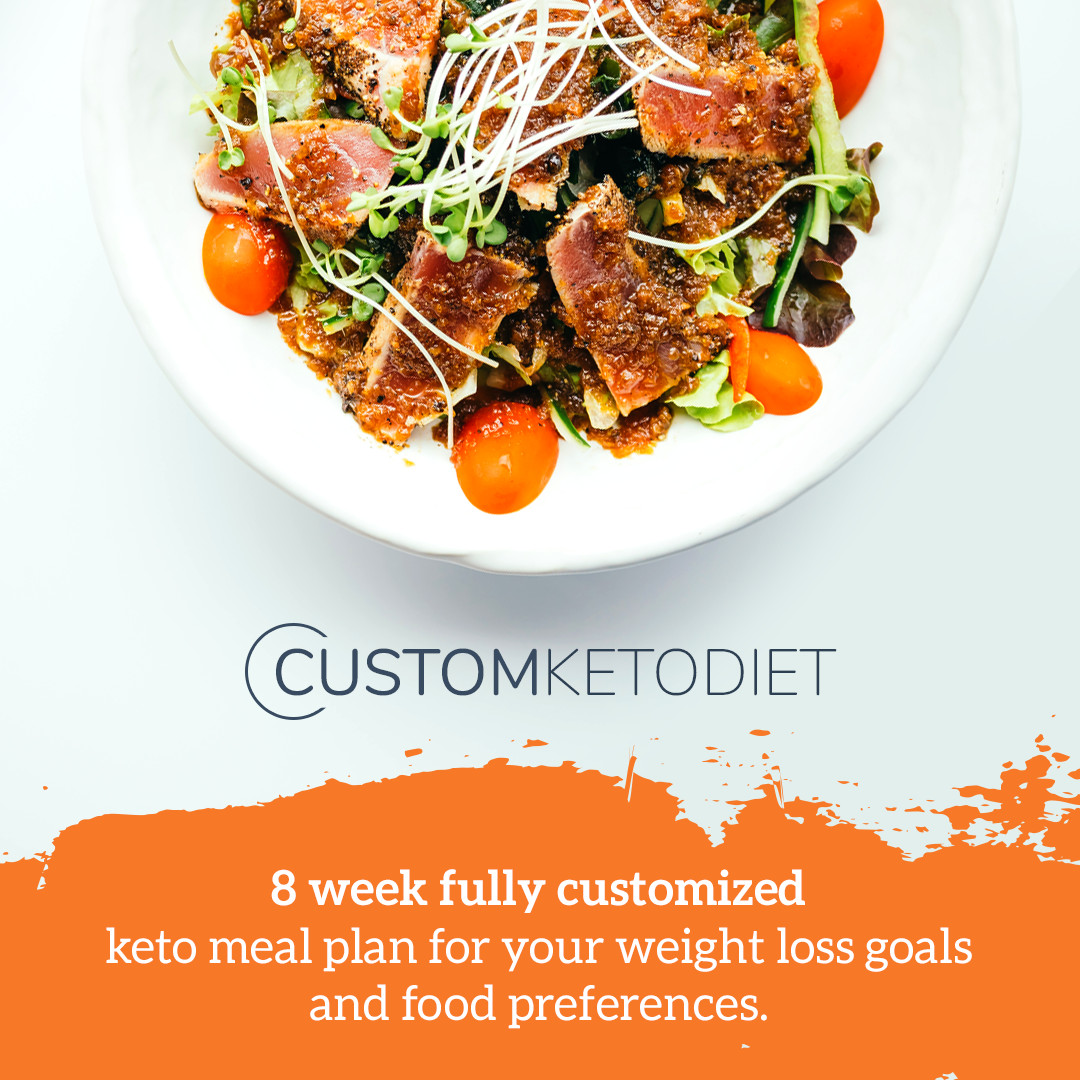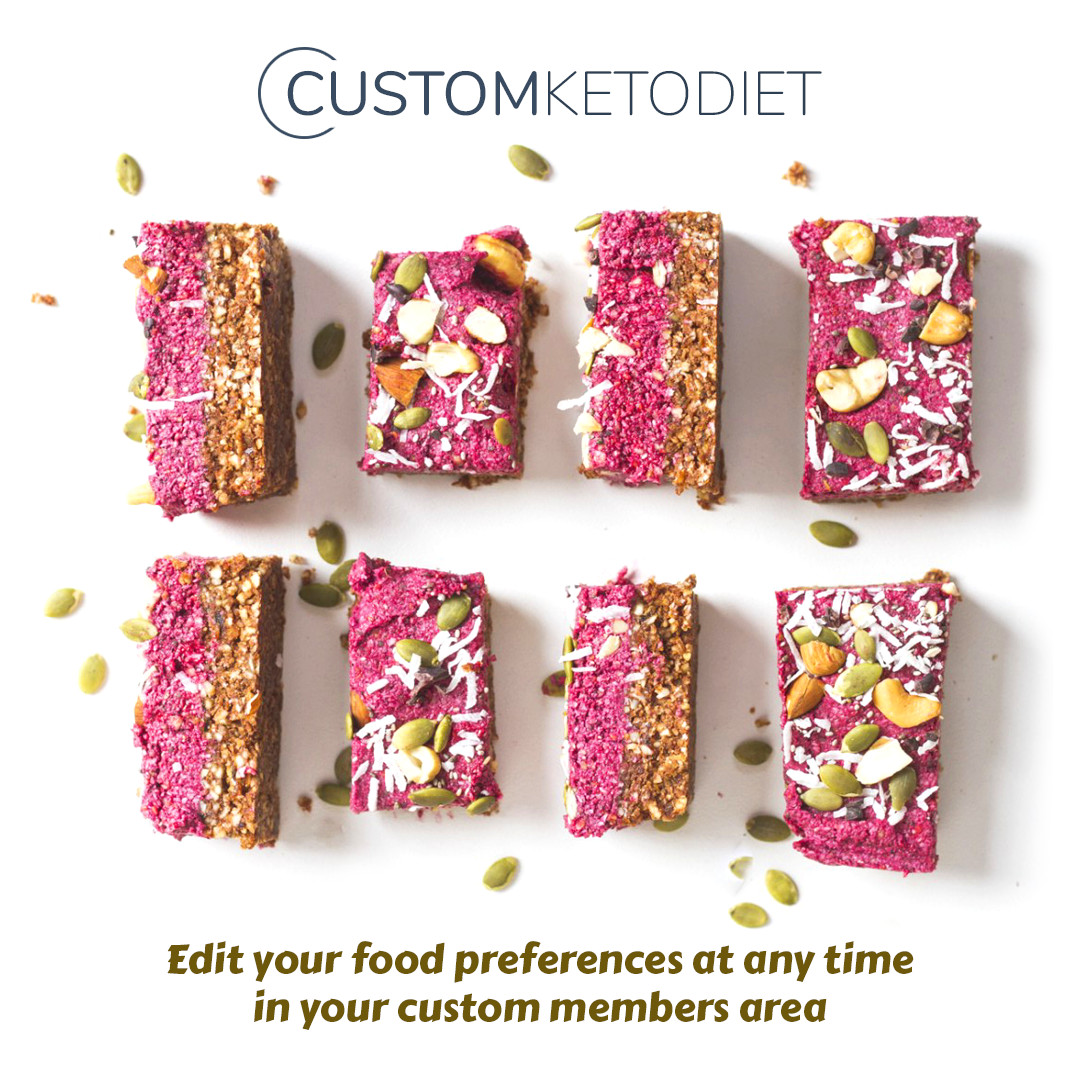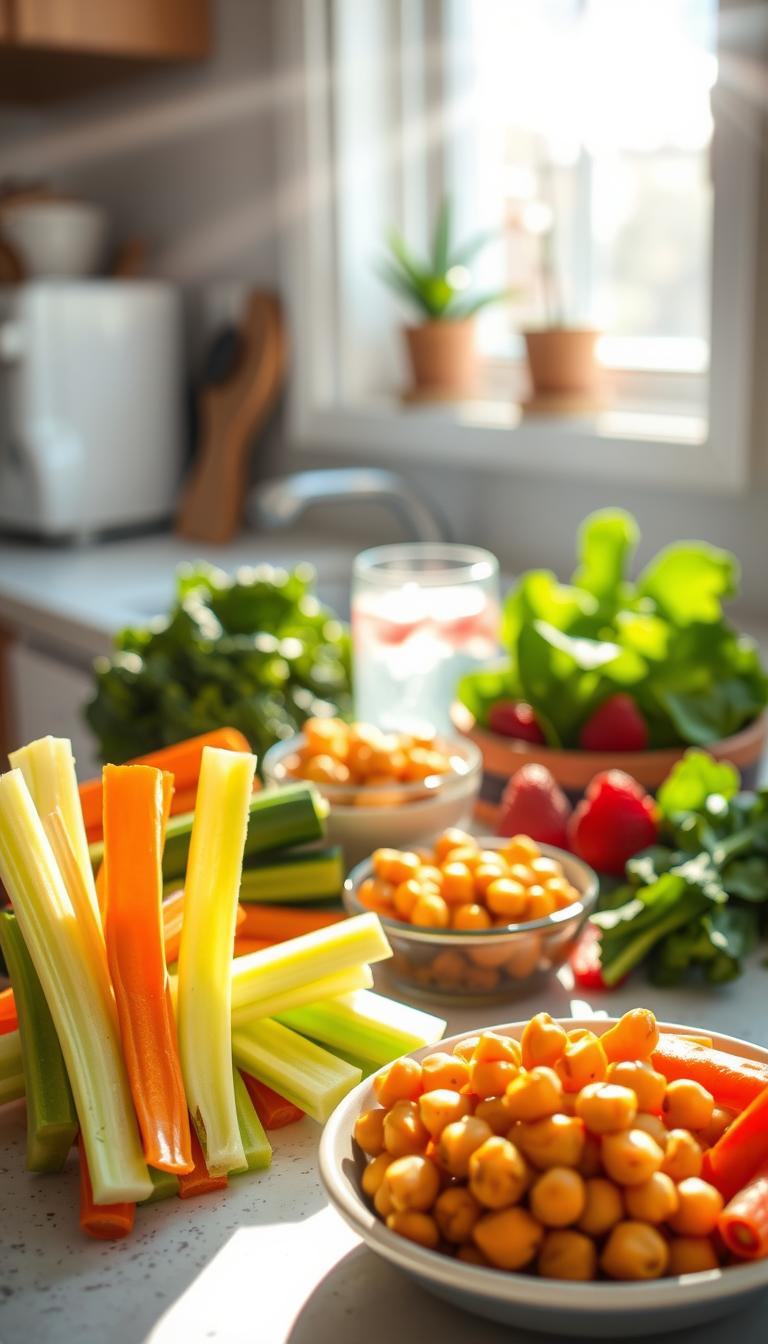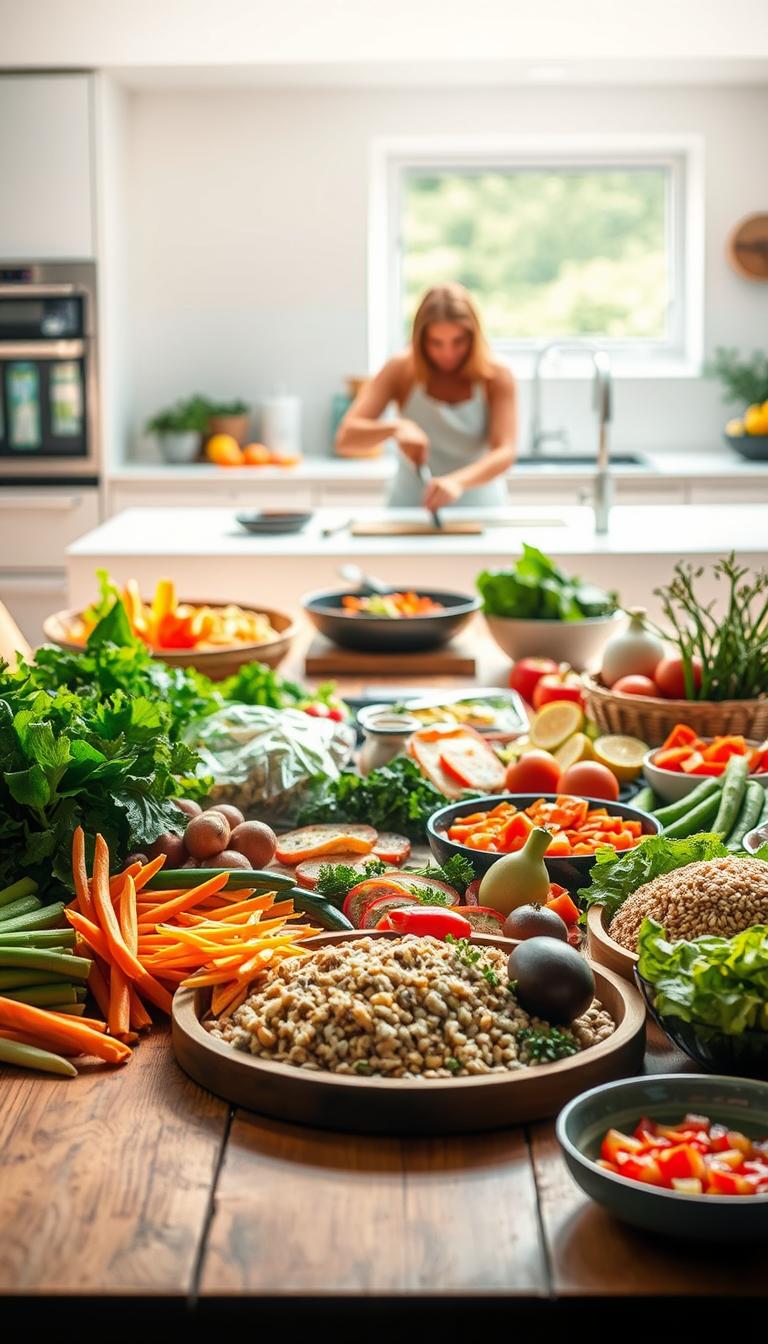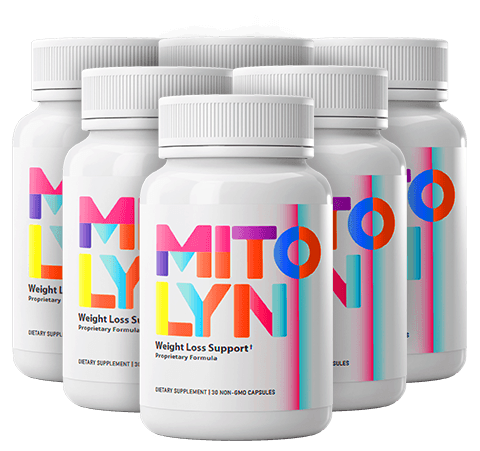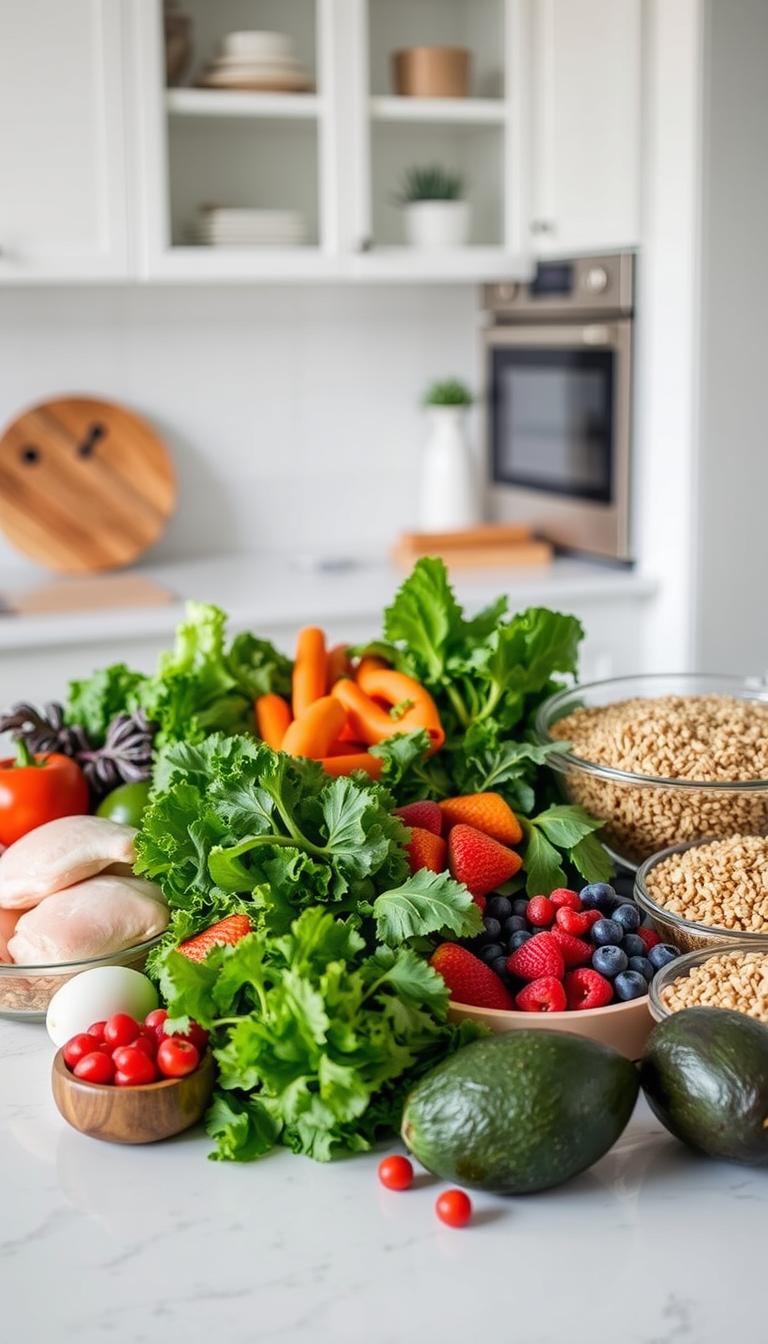
Start your day with warm banana-nut oatmeal. Fuel workouts with protein-rich snacks. Enjoy meals that keep you full, not hungry. This is what a well-planned calorie deficit diet offers.
Our weight loss meal plan is flexible yet structured. You can choose from 1,200-1,800 calories a day. It’s backed by ESHA Food Processor analysis for accuracy.
Each day includes high-protein foods like eggs and lean meats. You’ll also get fiber-rich veggies and whole grains. Imagine chipotle-lime cauliflower bowls with 5g of fiber per serving. Or hard-boiled eggs for a 70-calorie snack that stops cravings.
Key Takeaways
- Choose between 1,200-1,800 calorie options to match your energy needs
- Each plan includes 30-46g fiber and 45-77g protein daily
- Meal prep staples like baked oatmeal cups and taco bowls save time
- Scientifically validated with ESHA Food Processor analysis
- Customizable to fit your lifestyle while supporting 1-2 lbs weekly loss
Understanding the Science Behind Calorie Deficit for Weight Loss
Weight loss is simple: burn more calories than you eat. A calorie deficit for weight loss means your body uses fat for energy when you eat less. Here’s how it works:
What Exactly Is a Calorie Deficit?
Every action, like breathing or running, burns calories. A deficit occurs when you eat less than you burn. It’s like your body’s “energy budget.” To lose weight, you need to eat 3,500 calories less than your daily burn for each pound of fat. For example, eating 500 calories less daily means losing about 1 pound a week.
How Many Calories Should You Cut for Healthy Weight Loss?
Experts say to cut 250–500 calories daily for healthy calorie reduction. Cutting too many calories can slow your metabolism or make you tired. Here’s how to stay safe:
- Women: Aim for 1,200–1,500 calories/day minimum.
- Men: Target 1,500–1,800 calories/day minimum.
- Combine diet with exercise to boost results without drastic cuts.
The Metabolism Factor: Why Deficits Work Differently for Everyone
Your basal metabolic rate (BMR)—the calories burned at rest—varies. It depends on age, weight, and muscle mass. A 30-year-old athlete burns more than a sedentary person. Use this to personalize your plan:
- Calculate your BMR to set realistic goals.
- Adjust for activity levels: Desk jobs? Add exercise to boost burn.
- Track progress weekly to avoid plateaus.
Benefits of Following a Structured Calorie Deficit Meal Plan
Choosing a balanced calorie deficit meal plan does more than help you lose weight. It lets you control your diet without feeling left out. Here are the main benefits:
- Steady energy levels: Good weight loss nutrition keeps your body fueled with protein, fiber, and healthy fats.
- Curb cravings: Planning meals and portion sizes helps avoid hunger. This makes sticking to your diet easier.
- Save money and reduce waste: Meal prep helps avoid buying too much food. It can save up to 30% on grocery bills.
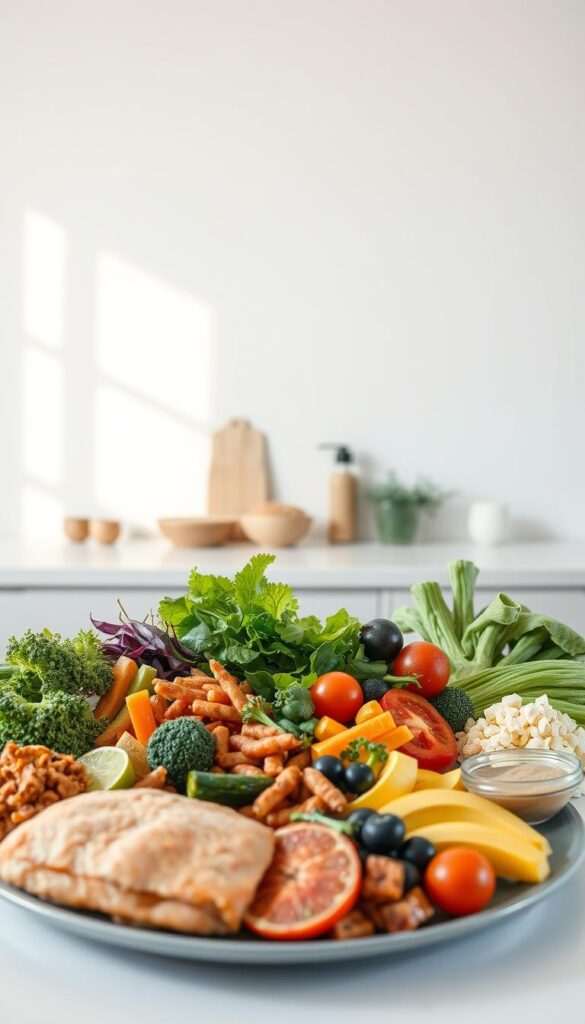
Structured plans also improve your mental focus. No more wondering “What’s for dinner?” reduces stress. Studies show that meal planners are twice as likely to keep weight off for a year. Here’s how planning compares:
| Structured Plan | Unstructured Dieting |
|---|---|
| 65% higher adherence rate | 30% drop-off within 2 weeks |
| 40% less food waste | Routine skipped meals/overeating |
These plans are not about being strict. They are guides for finding balance. Pair your sustainable weight loss plan with 150+ minutes of exercise each week for the best results. Are you ready to begin? Let’s look at how to figure out your personal deficit next.
Calculating Your Personal Calorie Needs for Weight Loss
Knowing how many calories you need is key to losing weight. We’ll show you how to make a plan that fits you using science.
Determining Your Basal Metabolic Rate (BMR)
Your basal metabolic rate (BMR) shows how many calories you burn when you’re not moving. Use the Mifflin-St Jeor equation:
| Gender | Formula |
|---|---|
| Women | BMR = (10 × weight in kg) + (6.25 × height in cm) – (5 × age) – 161 |
| Men | BMR = (10 × weight in kg) + (6.25 × height in cm) – (5 × age) + 5 |
For example, a 30-year-old woman weighing 68 kg and 165 cm tall: BMR = (10×68) + (6.25×165) – (5×30) – 161 = 1,433 calories/day

Factoring in Your Activity Level
Multiply your BMR by your activity factor:
- Sedentary (little to no exercise): ×1.2
- Lightly active (1–3 days/week): ×1.375
- Moderately active (3–5 days/week): ×1.55
- Very active (6–7 days/week): ×1.725
- Extra active (very hard exercise/sports & physical job): ×1.9
A moderately active person with a 1,433 BMR: 1,433 × 1.55 = ~2,222 daily maintenance calories
Creating Your Ideal Deficit Range
A safe deficit is 15–25% below maintenance. For the example above: 2,222 × 0.85 = 1,889–1,900 calories/day. Never go below 1,200 (women) or 1,500 (men) to protect your metabolism.
Consistency matters more than perfection. Adjust your plan weekly based on progress.
Use apps like MyFitnessPal to make calorie counting easier. It helps you stay on track.
Essential Nutrients to Prioritize in Your Calorie Deficit Journey
Choosing the right nutrients is key to a successful calorie deficit plan. Weight loss nutrition is more than just cutting calories. It’s about eating foods that give you energy, help keep muscle, and make you feel full. Let’s look at the nutrients you need to succeed.
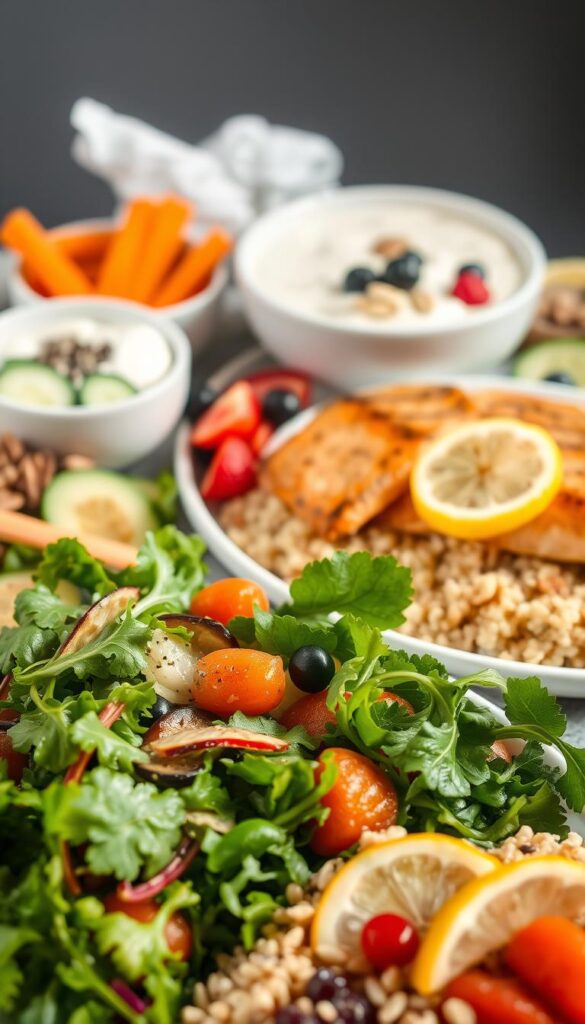
“Nutrient quality matters most when calories are reduced,” says Today’s Dietitian. “Prioritizing protein and fiber helps maintain metabolism and hunger control.”
Protein: Your Weight Loss Ally
Protein helps build muscle and burns calories when you digest it. Aim for 0.8–1g of protein per pound of body weight each day. Good sources of protein for weight loss include:
- Grilled chicken or turkey breast
- Wild-caught salmon or canned tuna
- Edamame, Greek yogurt, or tempeh
Healthy Fats That Keep You Satisfied
Healthy fats like avocado and nuts add flavor without extra calories. They help your body absorb nutrients better and reduce hunger. Choose:
- Avocado slices or guacamole
- Almonds, walnuts, or chia seeds
- Olive oil in salad dressings
Complex Carbs for Sustained Energy
Choose nutritious low-calorie meals with high-fiber carbs. Foods like oatmeal, quinoa, and veggies keep your energy up and blood sugar stable. Pair them with lean protein for longer satisfaction.
Micronutrients You Shouldn’t Overlook
Even small amounts of colorful veggies and berries are important. They give you vitamins and minerals. Spinach, broccoli, and citrus fruits help prevent deficiencies when you’re eating fewer calories.
Mix these nutrients into every meal. For example, a salmon salad with quinoa and avocado has protein, fiber, and healthy fats. This mix keeps you nourished while you lose weight.
7-Day Calorie Deficit Meal Plan for Beginners
Starting your weight loss meal plan doesn’t mean you have to give up taste. This healthy meal planning guide has nutritious low-calorie meals that keep you full and energized. You can adjust the portions to meet your calorie goals, whether you’re aiming for 1,200 or 1,500 calories a day.
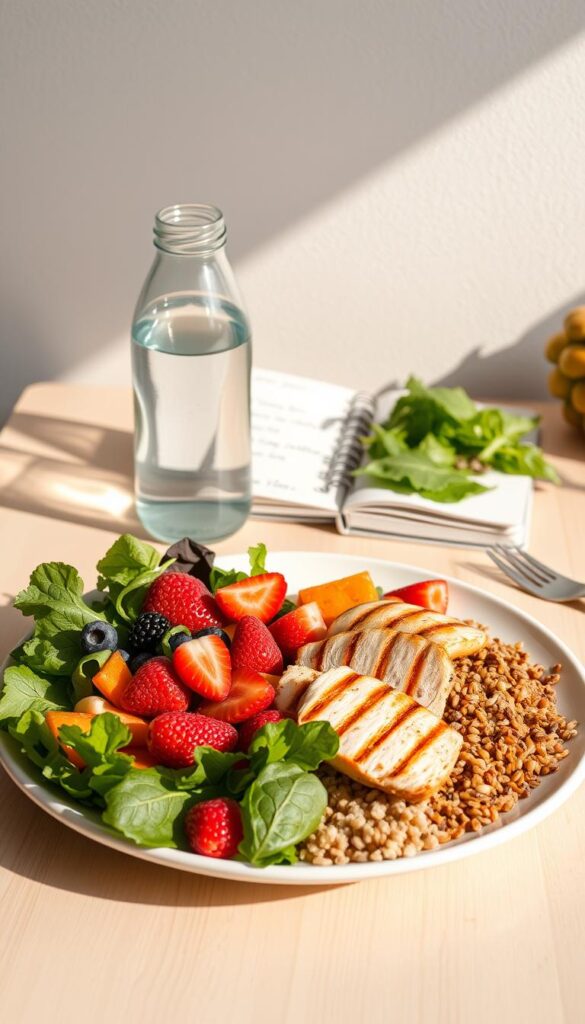
| Day | Breakfast | Lunch | Dinner | Snacks | Total Calories |
|---|---|---|---|---|---|
| Day 1 | Veggie Niçoise Pitas | Grilled Chicken Caesar Salad | Baked Salmon + Quinoa | Apple + 1 oz almonds | 1,200 |
| Day 2 | Whole-Wheat Toast + Avocado | Barbecue Chicken Cutlets + Citrus Slaw | Shrimp Stir-Fry with Brown Rice | Cottage Cheese + Pineapple | 1,250 |
| … | … | … | … | … | … |
Each meal has 25–30g protein to help keep your muscles strong. You can swap grilled chicken for tofu or chickpeas for a vegetarian option. Always drink water or herbal tea with your meals to stay hydrated.
- Prep veggies and grains on Sunday for quick meals
- Use a food scale to track your portions
- Swap snacks if you get cravings—like hummus + carrots instead of yogurt
Want more flexibility? You can adjust portions or add a 100-calorie treat like dark chocolate. Always talk to a dietitian if you think you’re missing nutrients like calcium or iron.
Time-Saving Meal Prep Strategies for Your Calorie Deficit Diet
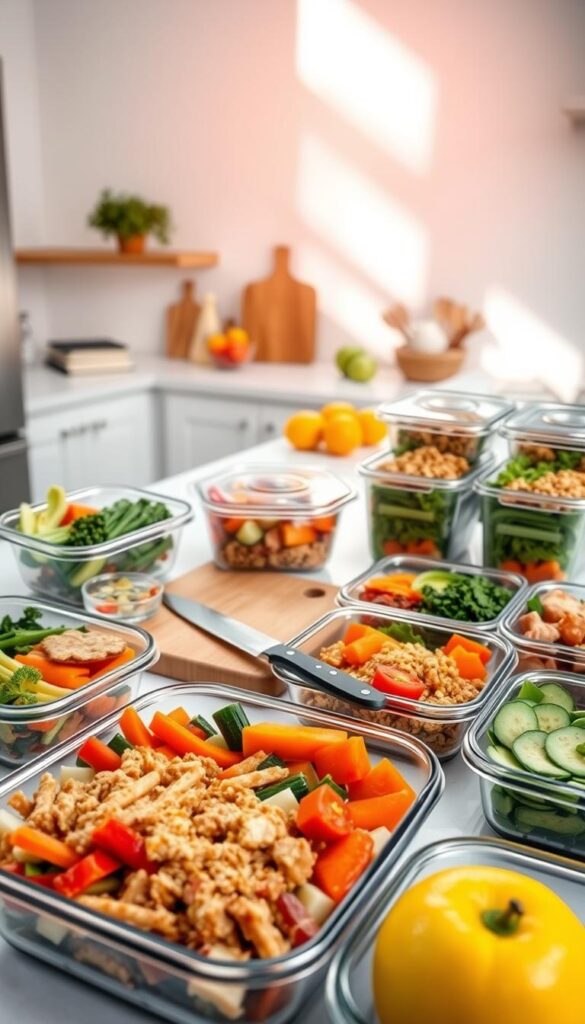
Meal prep for weight loss doesn’t have to be a hassle. With smart strategies, you can save a lot of time each week. This way, you can still meet your healthy meal planning goals. Here’s how:
Batch Cooking Fundamentals
- Cook proteins like chicken, tofu, or legumes in bulk—grill or bake a week’s worth at once.
- Prep grains (quinoa, brown rice) and roasted veggies (sweet potatoes, broccoli) for versatile use in meals.
- Follow a Sunday “assembly line” approach: chop, cook, and store in labeled containers.
Storage Solutions for Prepped Meals
| Food Type | Refrigeration | Freezing |
|---|---|---|
| Proteins | 3-4 days in airtight containers | Up to 3 months in freezer-safe bags |
| Grains | 5-7 days in glass jars | 2 months when vacuum-sealed |
| Vegetables | 5 days with oil-free storage | 6 months blanched first |
Quick Assembly Methods for Busy Weekdays
- Pair pre-cooked chicken with quinoa and roasted veggies for a 2-minute bowl.
- Layer prepped ingredients into salads or wraps using Mason jars or bento boxes.
- Repurpose leftovers: Turn grilled salmon into a salad topping or taco filling.
Consistency is key in a weight loss meal plan. Stock your kitchen with essentials like reusable containers (try Pyrex or Stasher bags) and pre-chopped veggies from brands like Green Giant. Small changes like these make it easier to stay on track without sacrificing time or taste.
Smart Swaps to Cut Calories Without Sacrificing Flavor
Small changes can make a big impact on your healthy weight loss diet. These smart substitutions keep meals satisfying while cutting calories—no blandness required. Let’s dive into swaps that boost nutrition without the guilt.
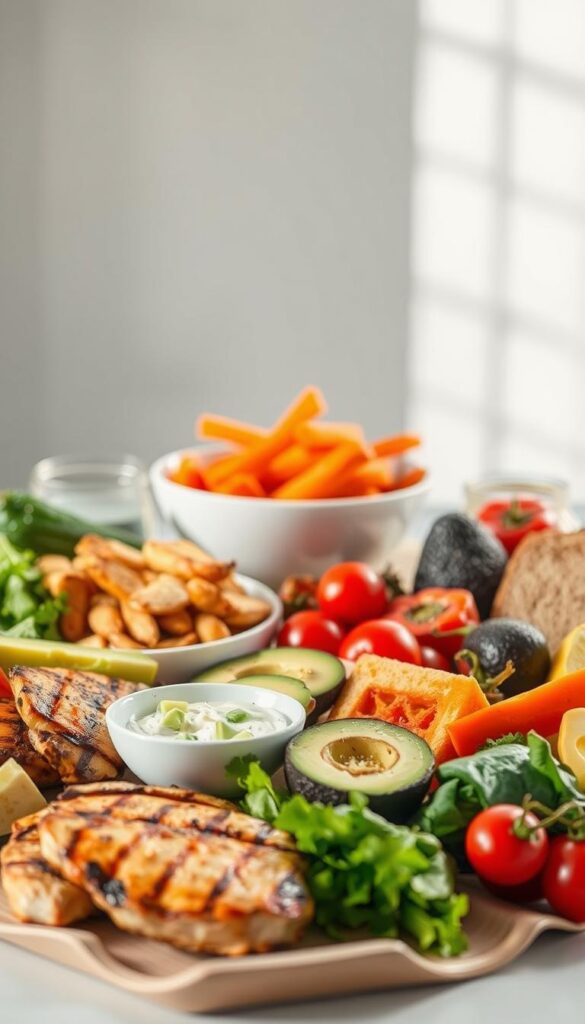
| Swap | Calorie Savings | Benefit |
|---|---|---|
| Sour cream → Greek yogurt | 50-100 calories | Adds protein to nutritious low-calorie meals. |
| White rice → Cauliflower rice | 150 calories per cup | More fiber, fewer carbs. |
| Regular bacon → Turkey bacon | 30% fewer calories | Lean protein with savory flavor. |
| Ice cream → Cinnamon-spiced Greek yogurt | 200+ calories saved | Sweetness from natural spices, not sugar. |
| Mayonnaise → Avocado spread | 50% fewer calories | Healthy fats boost satiety. |
“Flavor thrives on variety, not volume,” says dietitian Maria Lopez. “Try roasted veggies or citrus zests—they add punch without calories.”
- Trade sugary drinks for infused water (e.g., cucumber + mint).
- Swap chips for air-popped popcorn (3 cups = 90 calories vs. chips’ 150).
- Use lemon juice + mustard instead of creamy dressings (e.g., Kraft’s 5-calorie options).
Cook smart: Bake chicken instead of frying, or try an air-fryer for crispy veggies. Every choice adds up—these swaps turn your plate into a healthy calorie reduction strategy that’s easy to stick with. Taste stays rich, calories shrink quietly.
Overcoming Common Challenges on Your Calorie Deficit Meal Plan

Following a calorie deficit for weight loss can face challenges like hunger, social pressure, or weight loss plateaus. But, these obstacles don’t have to stop you. Making small changes can help you keep moving towards lasting weight loss without giving up your goals.
Dealing with Hunger and Cravings
Cravings often rise when your body resists the calorie deficit. Try these:
- Eat high-volume, low-calorie foods like salads, soups, and veggie snacks.
- Add protein (eggs, Greek yogurt) and fiber (oats, berries) to meals to stay full.
- Check if you’re really hungry before snacking. Try a walk or herbal tea first.
Navigating Social Situations and Dining Out
Eating out or at gatherings doesn’t have to mean giving up. Plan ahead:
- Choose restaurants with healthy options and order grilled or protein-rich dishes.
- Split entrees or save half for later to avoid eating too much.
- Set a “treat budget” for social events. Enjoy a small dessert, then stick to your plan.
Breaking Through Weight Loss Plateaus
Hit a weight loss plateau? Your metabolism adjusts to your current deficit. Try these:
- Use tools like MyFitnessPal to recalculate your calorie needs and adjust portions.
- Do more strength training to build muscle, which increases metabolism.
- Try a 1-2 day “reset” week with slightly more calories to kickstart your metabolism again.
Progress isn’t always straight. Celebrate small victories and remember that sticking with it and making smart changes can help you overcome plateaus and achieve your goals.
Sustainable Habits to Maintain Your Results Long-Term
Long-term weight management is a journey, not a finish line. It’s about building routines that feel natural. After reaching your goal, focus on a balanced calorie deficit. This keeps you energized without feeling deprived.
Studies show that structured meal plans help you succeed. But, to keep going, you need to make changes that feel right for you.

Begin with reverse dieting. Slowly add 100–200 calories each week to find your maintenance level. Then, keep your results by following these habits:
- Eat protein (20–25% of calories) and fiber-rich veggies at 80% of meals
- Move daily: 30 minutes of walking or yoga helps burn 150+ calories
- Track progress with apps like Healthi to spot small changes early
Structured meal planning leads to 6.5kg average weight loss over 12 weeks, per a 2023 clinical trial.
Mindful eating is important. Before snacks, ask yourself, “Am I hungry or bored?” Drinking 8 cups of water a day can make you feel full. Also, aim for 7–9 hours of sleep to balance hunger hormones.
Being flexible is crucial. Plan “treat days” but aim for an 80/20 balance. This means 80% of your food is nutrient-dense, and 20% is for fun. Batch-cooking saves time and keeps you on track. Celebrate small victories, like reaching 10,000 steps a week, to stay motivated.
Sustainable weight loss isn’t about being perfect. Small choices, like drinking water instead of soda or swapping chips for nuts, make a big difference. Focus on feeling energized, not just the number on the scale. With these habits, keeping up your progress gets easier over time.
Conclusion: Your Path to Success with a Calorie Deficit Approach
A calorie deficit meal plan is a clear way to lose weight. Focus on foods like chicken, fish, and veggies. This way, you can lose weight and stay full of energy.
It’s important to make your plan personal. A dietitian can create a diet just for you. Start with small changes, like meal prep or drinking more water. Add daily activity to see better results.
Slow, steady changes lead to lasting success. Begin with small steps, like adding a salad or a short walk. Celebrate every small victory, not just weight loss. Success is about moving forward, not being perfect. Let your plan grow with you. Every healthy choice brings you closer to a better life.
FAQ
What is a calorie deficit?
A calorie deficit happens when you eat fewer calories than your body uses. This makes your body use fat for energy, helping you lose weight.
How much weight can I expect to lose with a calorie deficit meal plan?
You can lose 1-2 pounds a week with a calorie deficit meal plan. This is a healthy and steady weight loss.
How do I calculate my Basal Metabolic Rate (BMR)?
To find your BMR, use the Harris-Benedict equation or online calculators. They look at your age, gender, weight, and height.
What are the recommended calorie reductions for safe weight loss?
Aim to cut 250-500 calories from your daily intake for safe weight loss. This is a good range for losing weight.
Why is nutrition more important than just cutting calories?
Eating nutrient-dense foods is key. It ensures you get the vitamins and minerals your body needs. This keeps your energy up and supports your health while losing weight.
What are some benefits of meal planning?
Meal planning reduces decision fatigue and keeps your energy levels steady. It also helps you shop better, save money, and enjoy food more.
Can I customize my meal plan?
Yes! You can tailor any meal plan to fit your tastes, dietary needs, and lifestyle. This way, you can enjoy your meals while staying on track.
How can I prepare meals efficiently for my calorie deficit plan?
Use batch cooking, organize your kitchen, and store prepped foods safely. This makes meal prep faster and more fun.
What are some effective ways to handle social situations while sticking to my meal plan?
Try different meals and snacks, look up restaurant menus ahead of time, and control your portions. This helps you enjoy social meals without feeling left out.
What should I do if I hit a weight loss plateau?
If you hit a plateau, check your calorie intake and activity levels. Also, try changing your macronutrient ratio to get moving again.

